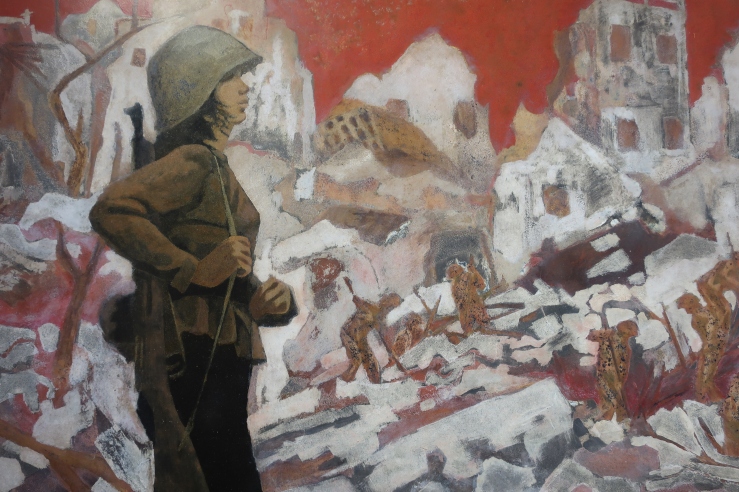
In Fractured, artworks diverse in form and narrative provide a more nuanced understanding of the past.
I met Adrian Jones, Founder and Executive Director of Witness Collection, at his home in George Town, the eclectic and multi-ethnic capital of Penang, Malaysia. The 8th annual George Town Festival was underway, which infused the city with creative energy as shophouses, derelict buildings, and public spaces transformed into art exhibits and performance venues. The month-long festival celebrates arts, culture, heritage, and community and aims to create “new and vibrant connections between the traditional and the contemporary, the past and the future.”
On a mid-August afternoon, I arrived on foot at 8 Gurney, the high-rise where Jones lives and showcases a portion of his extensive collection of Vietnamese art. I was here to see his contribution to the festival—an exhibition called Fractured: Art Inspired by Conflict.
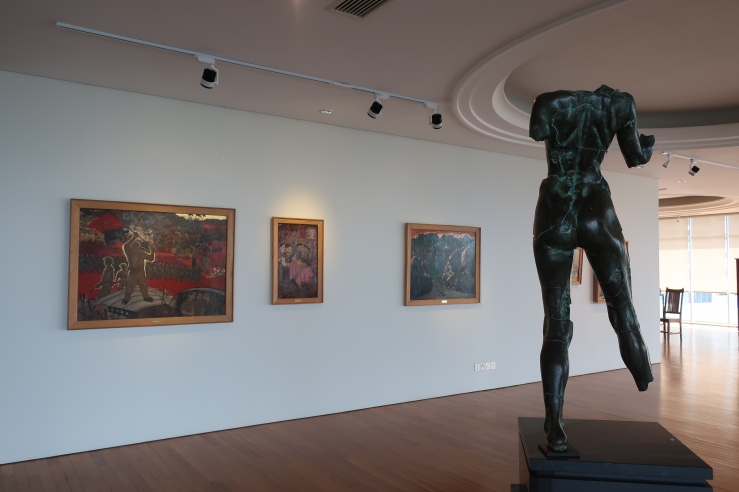
Jones greeted me at the building’s security station and we took the elevator up to the tenth floor. We removed our shoes and entered the air-conditioned foyer, a welcome respite from the grueling summer heat.
His home is airy. Natural light bathes the high, white walls. The minimalist domestic decor defers to the paintings and sculptures, allowing visitors to focus on the artworks. In many ways, the space is exactly what one expects from a formal, conventional museum, where patrons revere art and, perhaps, elevate it to the status of sacred. He calls his private gallery space base2.
In many ways, the space is exactly what one expects from a formal, conventional museum, where patrons revere art and, perhaps, elevate it to the status of sacred.
base2 contrasts with George Town’s streets, where locals and tourists interact with a kind of living art museum. Even outside of festival-time, the historic center—named a UNESCO World Heritage Site in 2008—exudes artistic innovation. Natthapon Muangkliang, Louise Low, and Tang Yeok Khang founded the 101 Lost Kittens Project which has resulted in a network of artists whose murals expand awareness of the stray animal crisis.
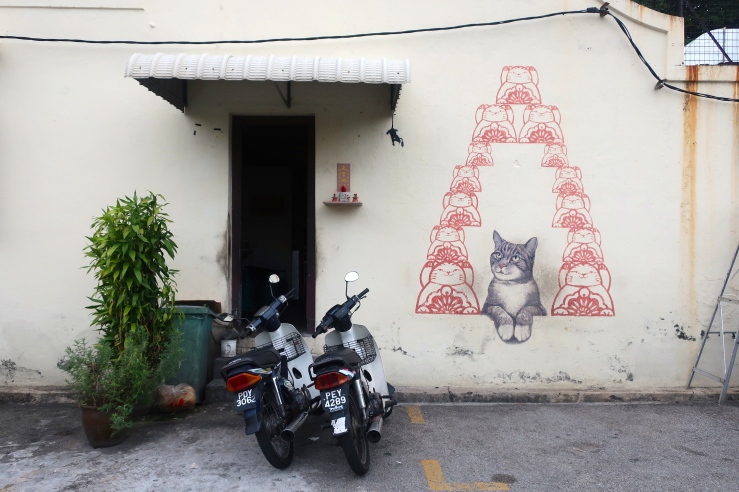
Lithuanian-born, Penang-based artist Ernest Zacharevic sparked a social media frenzy with his public artworks that use found objects to construct hybrid mural-sculptures that depict Penang street life. Many tourists come to the capital specifically to experience the works in person, participating in a kind of self-guided urban scavenger hunt for the dynamic images that will reveal themselves in unexpected corners of the city. Others follow Lonely Planet’s directions, beeline to their not-so-secret locations, and queue up for a chance to pose with and, thus, become the art.


But we should think of Jones’ gallery as a complement, rather than an alternative, to the art that one finds outside its bright walls. Fractured proves in concert with George Town Festival’s commitment to bridge the past and the future as it features works from the mid-twentieth century through 2016. The exhibition makes a compelling case for art’s vital role in documenting history in its complexity, and it rejects the notion that our past can be pinned down to a singular, coherent narrative.
The exhibit makes a compelling case for art’s vital role in documenting history in its complexity, and it rejects the notion that our past can be pinned down to a singular, coherent narrative.
All of the artworks in Fractured relate to Vietnam. Jones sought to borrow pieces that reflect past conflicts in Malaysia, such as the Japanese occupation (1941–1945) that impacted Penang, the first Malayan Emergency (1948–1960), and the subsequent Communist insurgency. However, artworks from these periods are scarce and Jones wasn’t able to find them; a testament to the importance of art conservation efforts.
Fractured benefits from Jones’ experience as a veteran art collector, a process he began in 1987, when, during an extended stay in Vietnam, he purchased the first pieces that would eventually emerge as a formal body of artworks. By 2002, he’d accumulated more than 200 pieces and realized that, moving forward, he needed to define a purpose for his collection. He spent a year doing extensive research and consulted more than forty Vietnamese individuals whose expertise spanned nearly all fields of Vietnamese art.
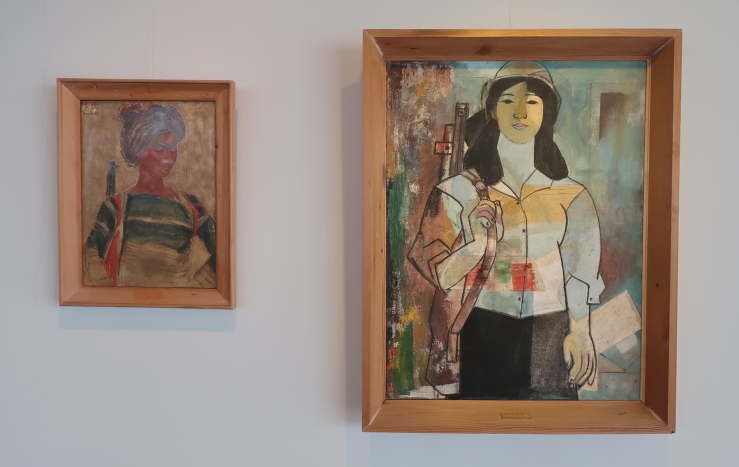
Jones also made the arduous task of collecting all of the artists’ personal histories a central feature of his project, which seeks to “tell the story of the artists and their experiences of extraordinary changes that occurred during their lifetimes.” Whenever possible, he met with the artists personally, or discussed their lives and work with those who knew them. Thus, in 2003, he aptly named the assembly of artworks Witness Collection.
The collection has grown to be one of the largest Vietnamese art collections in the world, consisting of approximately 2,000 works made by more than 120 important artists from the 1920s to the present, in—notably—both the north and the south of the country.
On selecting pieces from the collection for Fractured: Art Inspired by Conflict, Jones says the works that Vietnamese artists created during the conflicts in Vietnam are an incredibly important part of telling the Vietnamese’s own story—or, as is the case, a myriad of intertwined stories.

“There were no Kodak labs on the Ho Chi Minh trail,” he explains, “The Vietnamese didn’t have helicopters to fly film crews in and out. So their only real source of documentation were people writing and people creating art works to record their experience of life during the war time. In a country like Vietnam that endured 30 years of fighting from the Second World War through 1975, it’s inevitable that memories of that conflict—both the conflict itself, but also the daily life associated with that conflict—[are] featured strongly in the narrative of many of the artworks.”
Blake’s Fragments have raised more than 350,000 US dollars, which enables the removal of land mines and provides victim assistance.
Along with the historical examples of art inspired by conflict, Fractured features three contemporary artists working in distinct mediums. Canadian artist Blake Ward (often referred to simply as “Blake”) studied classical figurative sculpture in Paris and completed a teaching fellowship at the University of Hanoi in 2003. He subsequently traveled through Vietnam and Cambodia and was shocked to find that people were still dying from land mines more than 30 years after the war ended.
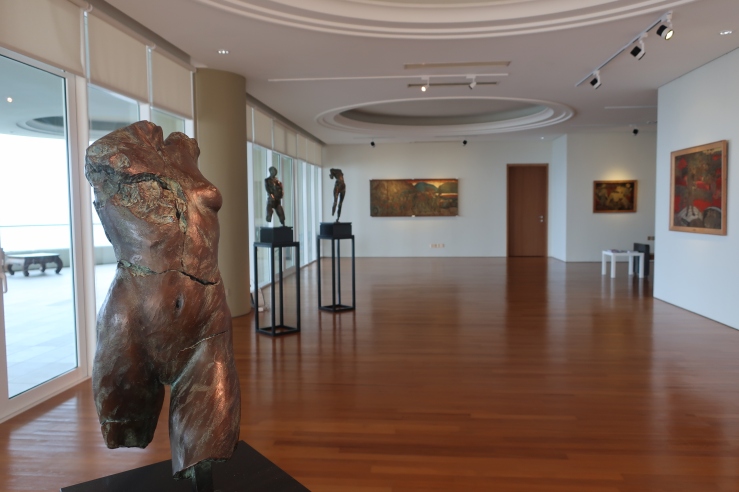
Blake created his Fragments series of “de-sculptured figures” to raise awareness of the international effects of unexploded ordinance. The work has raised more than 350,000 US dollars, which enables the removal of land mines and provides victim assistance.
George Burchett, who came to town for the exhibition, created the series Resistance, a set of silkscreen prints on traditional Vietnamese dó paper that depicts armed “Viet Cong girls.” George’s father was well-known Australian journalist Wilfred Burchett, one of the only Westerners based in the north of Vietnam during the war and reporting on the Ho Chi Minh side. George was born in Hanoi in 1955, one year after the Battle of Dien Bien Phu. His first language was Vietnamese and he tells me that as a boy he thought of the Viet Cong as his heroes.
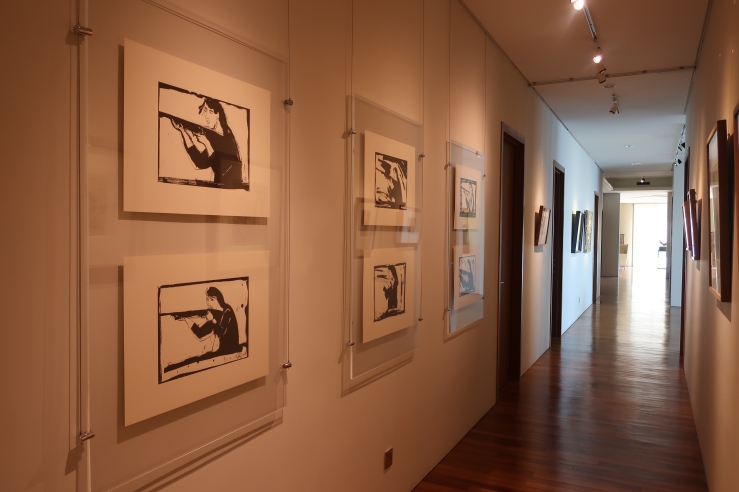
Burchett shares that his depiction of “the girls” have elicited interesting conversations because, “there are certain narratives attached to [their images] and immediately you have two sides to the narrative.” Scholars of the conflict in Vietnam and those who experienced it firsthand continue to interpret, debate, and revise its history.
Phan Đình Khánh, a recent graduate from Huế College of Arts, pushes the exhibition’s conflict theme beyond the battlefield. He layers his own digital photographs in order to generate dream-like composite images that depict societal tensions in both urban and rural environments.
Asiarta Foundation—which operates independently of Witness Collection, but of which Adrian Jones is also Executive Director—named Phan Đình Khánh the recipient of the Tu Lap Young Talent Award, a national youth prize in Vietnam. As part of the prize, Jones hosted the artist for three weeks in Penang, coinciding with part of George Town Festival.

In his 2016 tome Vietnam: A New History, Christopher E. Goscha reminds us that the country still finds itself at the center of global rivalries and he cautions us against one-dimensional accounts of Vietnam “driven by those who coveted, occupied, and fought over” the country. In this scenario, the country becomes “acted upon,” but never “quite an actor itself.” Goscha writes, “In the great power account, Vietnam is the victim of colonization and domination, never a colonizer or a conqueror itself. Its own internal divisions, ethnic diversity, and conflicts are obscured.”
The exhibition reminds us that transformative potential lies in exploring our complexities, even as we risk tensions in the process.
Fractured resists the trap of obscuring Vietnam’s complex history. The compilation of artworks rejects a reductive narrative in favor of bringing together diverse points of view—both social and artistic. The result is a more nuanced understanding of socio-political history in Southeast Asia than typical, dichotomous war narratives allow. The exhibition reminds us that transformative potential lies in exploring our complexities, even as we risk tensions in the process.
When I ask Adrian Jones what’s next for Witness Collection he says, “it’s very simple: it’s time for it to be seen.” His team, which includes full-time art conservators, have documented the numerous works, cleaned them, made necessary repairs, and mounted them.

They’ve loaned artworks to the National Museum of Contemporary Art in Korea and the National Gallery in Singapore, and international demand for loans grows. He’d love to bring the collection to the United States, though he acknowledges that “until very recently—and for some people still—there were a lot of raw nerves concerning Vietnam.”
The Getty Conservation Institute in Los Angeles has visited Witness Collection; the two organizations have considered the technical side of bringing the work to the United States, but there are no firm plans at this time. Jones thinks a United States audience would be quite surprised by the artworks coming from Vietnam. “Even though the war’s long gone,” he says, “there are still painful memories for many people who participated and it’s not always easy for the children of those parents to really understand everything that happened…We think that the art has a major role to play in that.”
Join me on a tour of Fractured, led by Adrian Jones!
Works Cited:
101 Lost Kittens. Facebook. www.facebook.com/101lostkittens. Web. Accessed October 2017.
Burchett, George. Personal Interview. 19 August 2017.
George Town Festival 2017. www.georgetownfestival.com/media/George-Town-Festival-2017-booklet. Web. Accessed September 2017.
Goscha, Christopher E. Vietnam: A New History. New York: Basic Books, 2016. EPUB file.
Jones, Adrian. Personal Interview. 19 August 2017.
Witness Collection. www.witnesscollection.com. Web. Accessed September 2017.

[…] If you haven’t yet read my review of the exhibition, begin here! […]
LikeLike
Thanks, MM, for a very inspiring look at the work of this artist. On to the video, and hopefully, a visit to the Getty to see his collection.
LikeLiked by 1 person
Yes, I hope–and truly think–we will see the artworks in the US in the future!
LikeLike
Quite interesting, M-M.even to an illiterate art lover. TNX
LikeLike
I’m glad you enjoyed it. I think you touch on something important: these works offer something far beyond the type of experience that might leave one feeling under-qualified to discuss the art. Witness Collection invites us all to think and talk about the works in terms of history, identity, and–yes–artistic craft. It’s possible to do this with all art, to varying degrees, but there’s something very special about the way the works are curated and put in conversation with one another in this collection.
LikeLike
Thank you M&M for sharing these stories. Amazing that these works of art was a way to document events instead of film/photo- feels so personal and powerful.
LikeLike
You’re so welcome, Kristen, and I agree! Thanks for sharing your thoughts.
LikeLike
A very bold and exciting undertaking by Adrian Jones. It allows us a glimpse into a very difficult and complex past.Thank you for giving this artwork and audience. Bravo.
LikeLike
Thank you for sharing your impressions! I think you’re right that this is a bold project and, to me, it feels quite refreshing to see the artists and their works regarded in the way Adrian Jones does. Exciting, indeed!
LikeLike
Like!! I blog quite often and I genuinely thank you for your information. The article has truly peaked my interest.
LikeLike
I’m so happy to hear that! Thanks for reading.
LikeLike